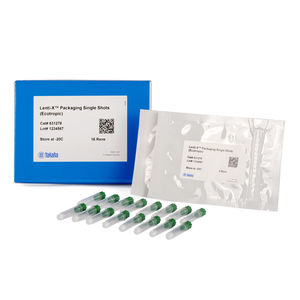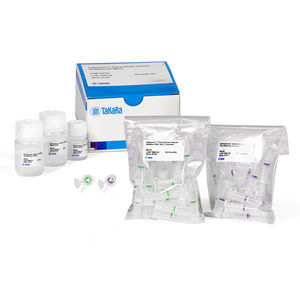
Antibody reagent kit ZsYellow1for molecular biologyprotein
Add to favorites
Compare this product
Characteristics
- Type
- antibody
- Applications
- for molecular biology
- Tested parameter
- protein
Description
ZsYellow1 has a true yellow emission, making it ideal for multicolor applications. Like all of our Living Colors fluorescent proteins, ZsYellow1 can be detected in cells without adding cofactors or substrates, which makes it ideal for use in live cell assays. The gene for ZsYellow1 has been human codon-optimized to enhance its translation in mammalian cells, and for higher solubility, brighter emission, and rapid chromophore maturation (8–12 hours).
The ZsYellow1 fluorescent protein can be used as a molecular tag or as a reporter to visualize, track, and quantify cellular processes including protein synthesis and turnover, protein translocation, gene induction, and cell lineage. Because its excitation and emission spectra are distinct from our other fluorescent proteins, ZsYellow1 can be used for multiplex applications—that is, to simultaneously detect two or more events in the same cell or cell population. For example, it can be used in two- and three-color analyses with AmCyan1 and/or HcRed1. Like all of our Living Colors fluorescent proteins, ZsYellow1 is ideal for monitoring gene expression and protein localization in vivo, in situ, and in real time.
pZsYellow1-N1 is a human codon-optimized expression vector that encodes a variant of the Zoanthus sp. yellow fluorescent protein, ZsYellow1, which has been engineered for brighter fluorescence and higher expression in mammalian cells. pZsYellow1-N1 allows genes cloned into the multiple cloning site (MCS) upstream of the ZsYellow1 coding sequence to be expressed as fusions to the N-terminus of the fluorescent protein. The unmodified vector will express ZsYellow1 in mammalian cells.
Catalogs
No catalogs are available for this product.
See all of TAKARA‘s catalogsRelated Searches
- Assay kit
- Solution reagent kit
- Blood assay kit
- Molecular biology reagent kit
- Serum assay kit
- Immunoassay assay kit
- Plasma assay kit
- Research reagent kit
- Infectious disease detection kit
- Protein reagent kit
- Diagnostic reagent kit
- Laboratory reagent kit
- Enzyme reagent kit
- Molecular test kit
- Histology reagent kit
- Reagent medium reagent kit
- Immunology reagent
- Cassette assay kit
- Cytology reagent kit
- Dye reagent
*Prices are pre-tax. They exclude delivery charges and customs duties and do not include additional charges for installation or activation options. Prices are indicative only and may vary by country, with changes to the cost of raw materials and exchange rates.





